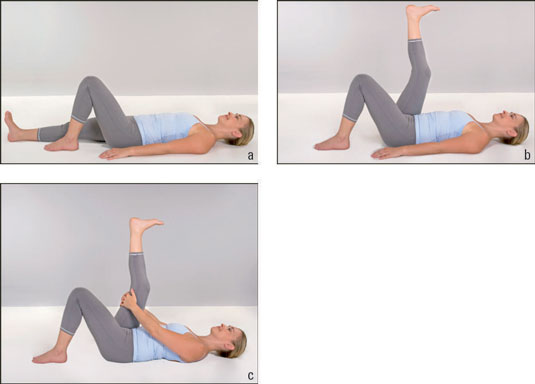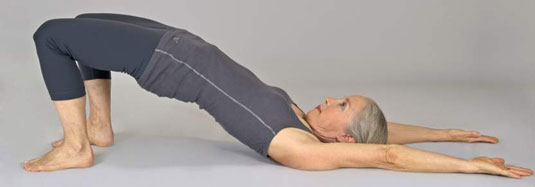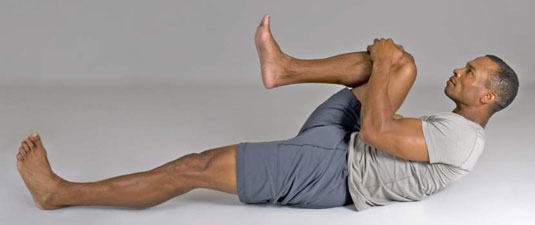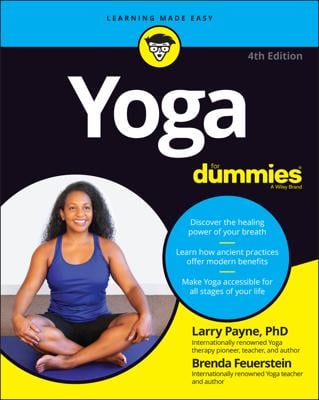Most Yoga practitioners enjoy reclining (supine) exercises because the postures are intrinsically relaxing. When you pair them with warm-ups, the combination effectively allows you to warm-up specific muscles or muscle groups while keeping the other muscles at rest.
The following warm-up exercises require you to start with the corpse posture (or dead posture). These exercises help revive you even when you start your Yoga session dead tired (pun intended).
Lying arm raise
Many of the muscles that go to the neck start between your shoulder blades. Raising the arms brings circulation to frequent sights of tension.
Lie flat on your back with your arms relaxed at your sides and your palms turned down.
As you inhale, slowly raise your arms over your head and touch the floor.
As you exhale, bring your arms back to your sides as in Step 1.
Repeat Steps 1 through 3, six to eight times.
The double breath
If you want to double your pleasure, the double breath enhances tension release in your body and prepares your muscles for the main postures.
Repeat Steps 1 and 2 of the lying arm raise.
After you raise your arms overhead on the inhalation, leave them on the floor above your head and fully exhale.
Your arms should remain where they are for another inhalation while you deeply stretch your entire body from the tips of your toes to your fingertips.
On the next exhalation, return your arms to your sides and relax your legs; repeat 3 to 4 times.
Knee-to-chest posture
Use this exercise for either warm-up or compensation. The knee-to-chest posture is also a classic in lower-back programs.
Lie on your back with your knees bent and feet flat on the floor.
As you exhale, bring your right knee into your chest, holding your shin just below your knee
If you have knee problems, hold the back of your thigh rather than your shin
If you can do so comfortably, straighten your left leg on the floor.
If you have back problems, though, keep your left knee bent.
Repeat Steps 1 through 3 on the other side, holding each side for 6 to 8 breaths.
Double leg extension
This exercise, which uses both legs simultaneously, has a dual function. It prepares the lower back and gently stretches the hamstrings.
Lie on your back and bring your bent knees toward your chest.
Hold the backs of your thighs at arms’ length.
As you inhale, straighten both legs perpendicular to the floor; as you exhale, bend both legs again.
Repeat Steps 2 and 3 six to eight times.
Hamstring stretch
Without the hamstrings (the muscles and the associated tendons), you’d have to let your fingers do all the walking. The hamstrings can be injured quite easily, especially if you overwork them, so you want to prepare them properly for exercise.
Lying on your back with your legs straight, place your arms along your sides with your palms down.
Bend just your left knee and put that foot on the floor.
As you exhale, bring your right leg up as straight as possible. As you inhale, return your right leg to the floor.
Keep your head and your hips on the floor.
Repeat Steps 3 and 4 three times and then, with your hands interlocked on the back of your raised thigh just above your knee, hold your leg in place for 6 to 8 breaths.
Repeat Steps 1 through 4 on the other side.

Support your head with a pillow or folded blanket if the back of your neck or your throat tenses when you raise or lower your leg.
Dynamic bridge: Dvipada pitha
You can use this exercise for warm-up and compensation and as a main posture. The Sanskrit term dvipada means “two-footed” and pitha means “seat,” which is a synonym for asana. (The pronunciation is dvee-pah-dah peet-hah.)
Lie on your back with your knees bent, feet flat on the floor at hip width, and your arms at your sides with palms turned down.
As you inhale, raise your hips to a comfortable height.
As you exhale, return your hips to the floor.
Repeat Steps 3 and 4 six to eight times.

Bridge variation with arm raise
This posture is another good candidate for both warm-up and compensation.
Lie on your back with your knees bent, your feet flat on the floor at hip width, and your arms at your sides with palms turned down.
As you inhale, raise your hips to a comfortable height and at the same time raise your arms overhead to touch the floor.
As you exhale, return your hips to the floor and your arms to your sides.
Repeat Steps 3 and 4 six to eight times.

Dynamic head-to-knee
The dynamic head-to-knee is a nice warm-up before a slightly more physical routine.
Dynamic head-to-knee is a little more vigorous kind of warm-up. Don’t perform this sequence if you’re having neck problems.
Lie flat on your back with your arms relaxed at your sides and you palms turned down.
As you inhale, raise your arms slowly overhead and touch the floor.
As you exhale, draw your right knee toward your chest, lift your head off the floor, and then grasp your right knee with your hands.
Keep your hips on the floor. Bring your head as close to your knee as possible, but don’t force it.
As you inhale, release your knee and return your head, arms, and straightened right leg to the floor as they are in Step 2.
Repeat Steps 2 through 4 six to eight times on each side, alternating right and left.
To make the sequence a little easier, keep your head on the floor in Step 3.


